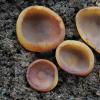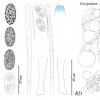
04-08-2014 19:19
 Alan Rockefeller
Alan Rockefeller
This came into the Cuajimoloyas fungus fair last w

03-08-2014 22:48
SYLVAIN ARDBonjour,Si l'un de vous a ces articles :Petrini, L

02-08-2014 09:53
 Maren Kamke
Maren Kamke
Hi everybody,I found this Mollisia species on a gr

03-08-2014 12:48
 Rubén Martínez-Gil
Rubén Martínez-Gil
Hola a todos. Subo unas fotos de una Peziza que e

01-08-2014 20:25
Gernot FriebesHi,I found this species on a decorticated branch o

02-08-2014 11:25
Marja PennanenHello forum,when these black spots open, they show

30-07-2014 18:11
 Christian Lechat
Christian Lechat
Dear friends mycologists,I just inform you that th
Peziza 5421
Leandro Sánchez,
05-08-2014 09:11
 Sous Quercus, jusqu'à 30 mm diamètre.
Sous Quercus, jusqu'à 30 mm diamètre.Lait jaune-verdâtre
Peziza succosella?
Cordialement
Michel Hairaud,
05-08-2014 09:18

Re : Peziza 5421
Bonjour Leandro,
As tu mesuré les spores dans l'eau et sur sporée ? Malgré leur taille un peu réduite, elles sont biguttulées comme chez P. succosa.
Il y a une teinte rouge (artificiellement ?) prononcée sur l'image.
Amitiés
Michel
Leandro Sánchez,
05-08-2014 09:26

Re : Peziza 5421
Oui, les espores sont mesures dans l'eau, ne pas esporée, sont liberées per les asques sans pression.
La couleur est naturel, peut-être la chaleur.
Cordialement
La couleur est naturel, peut-être la chaleur.
Cordialement
DirkW,
05-08-2014 09:28

Re : Peziza 5421
salut,
to me this is a perfect p. michelii.
best
dirk
to me this is a perfect p. michelii.
best
dirk
Gilbert MOYNE,
05-08-2014 10:03
Re : Peziza 5421
Le reflet violacé sur les apothècies me ferait plutôt penser à Peziza michelii.
Gilbert
Gilbert
Gilbert MOYNE,
05-08-2014 10:03
Re : Peziza 5421
Le reflet violacé sur les apothècies me ferait plutôt penser à Peziza michelii.
Gilbert
Gilbert
DirkW,
05-08-2014 10:10

Re : Peziza 5421
salut gilbert,
in my experience the combination of a more or less violet coloured hymenium and yellow-brown outside is very characteristic for michelii. is there another peziza with this feature - no idea ...
but sometimes the violet is lacking ...
best
dirk
in my experience the combination of a more or less violet coloured hymenium and yellow-brown outside is very characteristic for michelii. is there another peziza with this feature - no idea ...
but sometimes the violet is lacking ...
best
dirk
René Dougoud,
05-08-2014 10:24
Re : Peziza 5421
Oui, Peziza michelii (Boud.) Dennis. Une espère qui présente toujours, lorsque jeune, un hyménium coloré de violet. Cette teinte disparait souvent totalement sur l'adulte. La couleur de la chair présente alors très souvent une teinte jaune (déjà visible sur les photos présentées plus haut). Ce jaunissement est causé par la présence du suc dans la chair, suc qui exude à la cassure, à la piqûre (sur les exempl. en bon état de fraicheur). Une manière de contrôler le jaunissement du suc et de le mettre sur un ongle, le jaunissement devient visible en 1 minute environ (aussi valable pour P. succosa et voisins). En effet le jaunissement n'est pas toujours évident à observé sur le champignon, l'oxidation semble ralentie.
Cordialement
René
Cordialement
René
Leandro Sánchez,
05-08-2014 10:57

Re : Peziza 5421
Merci beaucoup à tous
Cordialement
Cordialement

 micro5421-0001.jpg
micro5421-0001.jpg